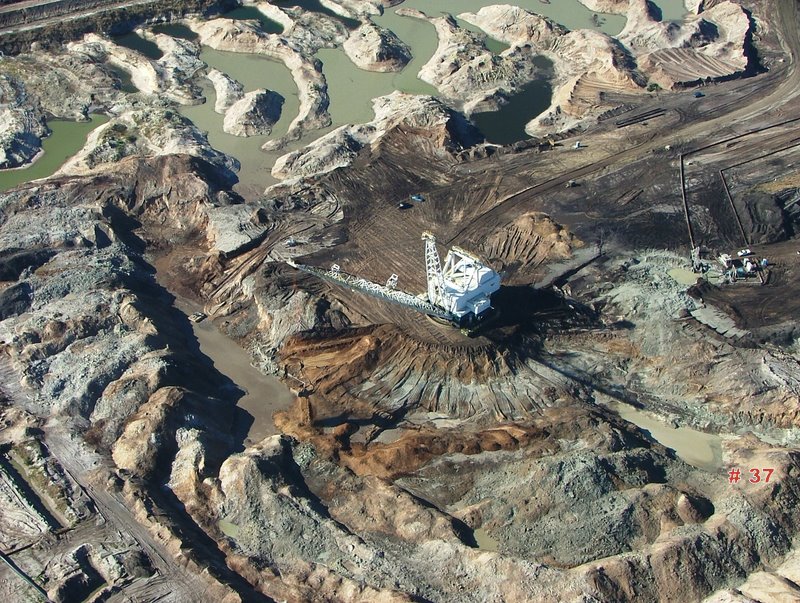The Peace River Heartland is also part of what is known as Bone Valley. That is why the counties of Hillsborough, Polk, Manatee, Hardee and Desoto counties are being strip mined.
A Short History
Phosphate is a natural, non-renewable resource that is obtained by mining phosphate-containing minerals. Florida’s phosphate rock deposits are believed to have originated when conditions in the seawater caused dissolved phosphorus to solidify and form the sediment that is mined today. Sea life also played a big part in forming the sediment deposits.
An Army Corps of Engineers captain first discovered River Pebble Phosphate along the Peace River, Florida in the late nineteenth century. Mining the phosphate began soon after. The Florida miners had no mechanized excavation equipment. That means early mining was by hand using wheelbarrows, wagons, picks and shovels. The chore of mining was slow and labor intensive, but the phosphate pebble did show promise. Interest in this pebble increases and the phosphate industry was born.
The early twentieth century brought mechanized excavation equipment like steam shovels to the Florida phosphate mines, but steam shovels didn’t last long. Draglines were first introduced in the 1920s and increased in usage since.
Dragline technology continued to advance, leading miners to move from the river-pebble to the land-pebble and hard-rock phosphates, and then to mining the finer-grained “phosphate matrix”. Phosphate matrix deposits occur over a wide area of west-central Florida known as the “Bone Valley”.
In 1900 it took 3 to 4 years to mine 15 acres with picks and shovels. In the early days of the small draglines, about 5 acres were mined in a year. As draglines grew in size, draglines were able to mine 500 to 600 acres a year. Conservatively, today’s draglines are able to completely destroy 50 acres a month.
Phosphate Mining Process
Florida’s phosphate ore (matrix) is found some 40 feet below the earth’s surface. The matrix lies intertwined with one of Florida’s real treasures, aquifer systems. Phosphate rock is mined and then manufactured through the fertilizer manufacturing process. A typical Florida phosphate mine gets about 9,000 tons of phosphate rock per acre of land.
Huge draglines are brought in and can remove the Florida earth from the surface down 100 feet in depth in order to remove the entire matrix “field”. The phosphate industry refers the removed earth as “overburden”. The rest of us call it orange groves, cattle pastures, the old swimming hole, watersheds, aquifer systems, rivers, natural springs, etc. Once the overburden is removed, the draglines can then “strip” out the matrix, which consists of equal parts of phosphate rock, clay and sand.
The matrix is then dumped in huge slurry pits where literally untold volumes of fresh clean aquifer water are used. The water comes from the newly crushed aquifers under the mighty dragline. Billions of gallons of Florida’s freshwater are released and used in high-pressure water cannons to create a slurry that can then be pumped to the beneficiation plant, which can be up to 10 miles away. At the beneficiation plant, the phosphate is separated from the sand and clay. Then the toxic sludge is stored in huge clay settling ponds until untold amounts of aquifer water evaporate.
One by-product, called phosphogypsum, is slightly radioactive so it cannot be easily disposed of. The only thing the miners can do with it is stacked in mountainous piles next to the processing plants. Florida is such a flat state that the 150-foot-tall “gyp stacks” are usually the highest point in the landscape for miles around. They contain large pools that can be as large as one square mile of highly acidic wastewater.
Not surprising, mining and mineral processing facilities generate more toxic and hazardous waste than any other industrial sector. “Reducing environmental impacts from large fertilizer manufacturers operations is a national priority for EPA.
The United States produces the most phosphate in the world, while Morocco and China rank second and third, respectively. Phosphate reserves are found in Central Florida, North Carolina, Utah, and Idaho. Florida is presently providing approximately 75 percent of the nation’s supply of phosphate fertilizer and about 25 percent of the world supply.
Follow the Money
Florida’s phosphate deposits today are the basis of an $85 billion industry supplying the lion’s share of the phosphate consumed in the United States. Out of the $85 billion value of the industry, only a few million dollars is spent on the local communities where the mines are located. Some have called this a boon for the local communities. However, the phosphate industry seems to be a bad neighbor. This is because they are “allowed” to leave their environmental catastrophes behind for those local citizens to pay for. Interestingly, the Central Florida phosphate mines are now referred to as “Bone Valley”. This $85 billion phosphate production area is located in the middle of one of Florida’s greatest natural treasures called aquifer systems or “water tables”. These aquifer systems can be compared to beehives, where the aquifer system is the hive and the water replaces the honey. This is considered a basis for Florida’s entire clean fresh water source.
Today, this Central Florida Phosphate Region consists of Hillsborough, Polk, Hardee, DeSoto, and Manatee Counties. These same counties also contain huge watersheds including the Alafia River Watershed, the Peace River Watershed, the Manatee River Watershed, the Little Manatee River Watershed and the Myakka River Watershed.
As of this article, the phosphate industry continues to purchase more land earmarked to strip mine the valuable phosphate in the watersheds mentioned above. The Florida phosphate dilemma continues to escalate, causing more extensive irreparable environmental damage daily.
Additional Information
Florida Institute of Phosphate Research (FIPR)
Florida DEP Mining and Minerals Regulation
Watershed Data
Peace River Cumulative Impact Study
U.S. Army Corps of Engineers – Jacksonville District
Article source:
https://ezinearticles.com/?A-Closer-Look-Into-Floridas-Phosphate-Mining-Industry&id=9193853
A CLOSER LOOK INTO FLORIDA’S PHOSPHATE MINING INDUSTRY
by David Hammock on Oct 10, 2015

